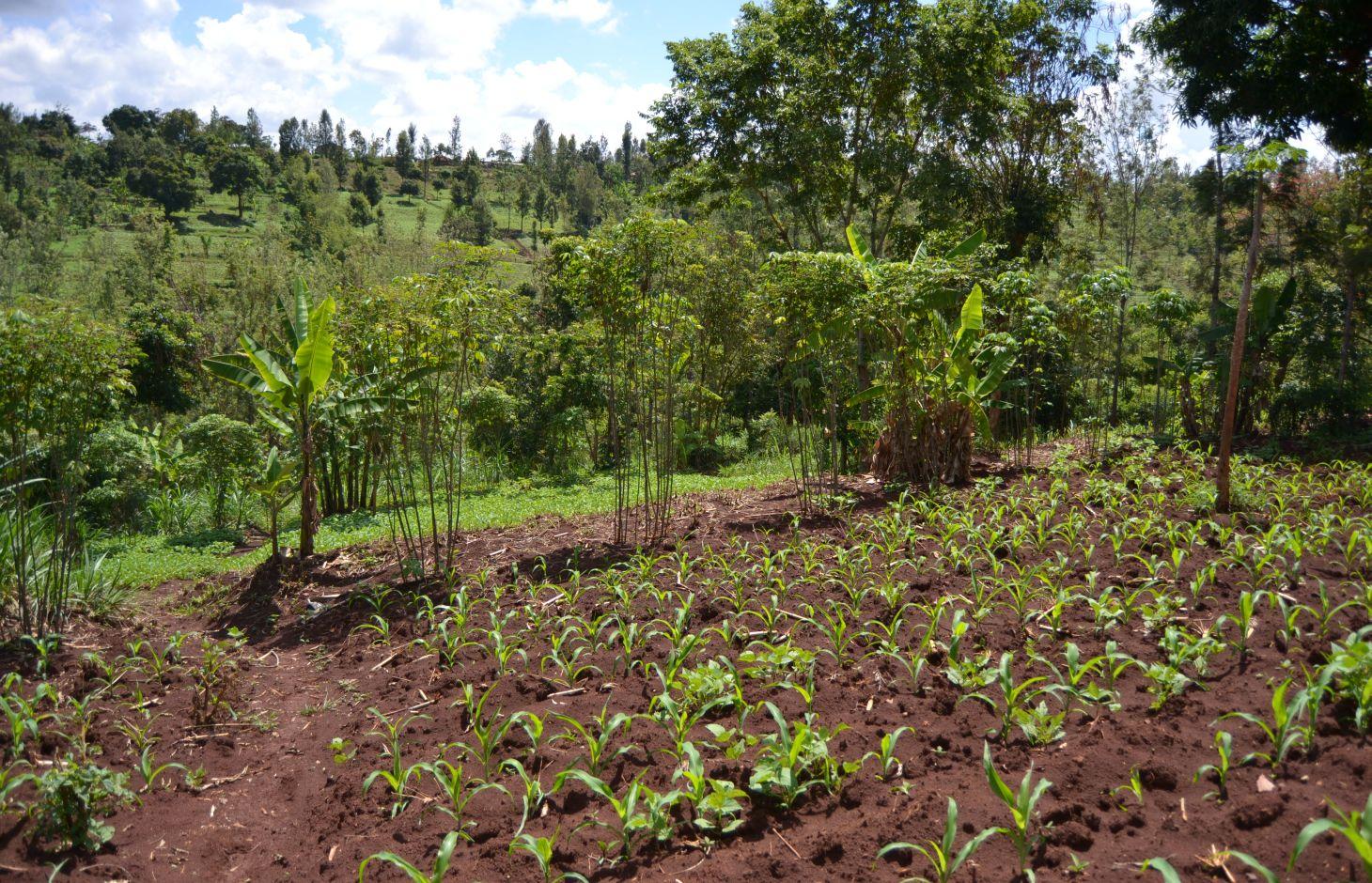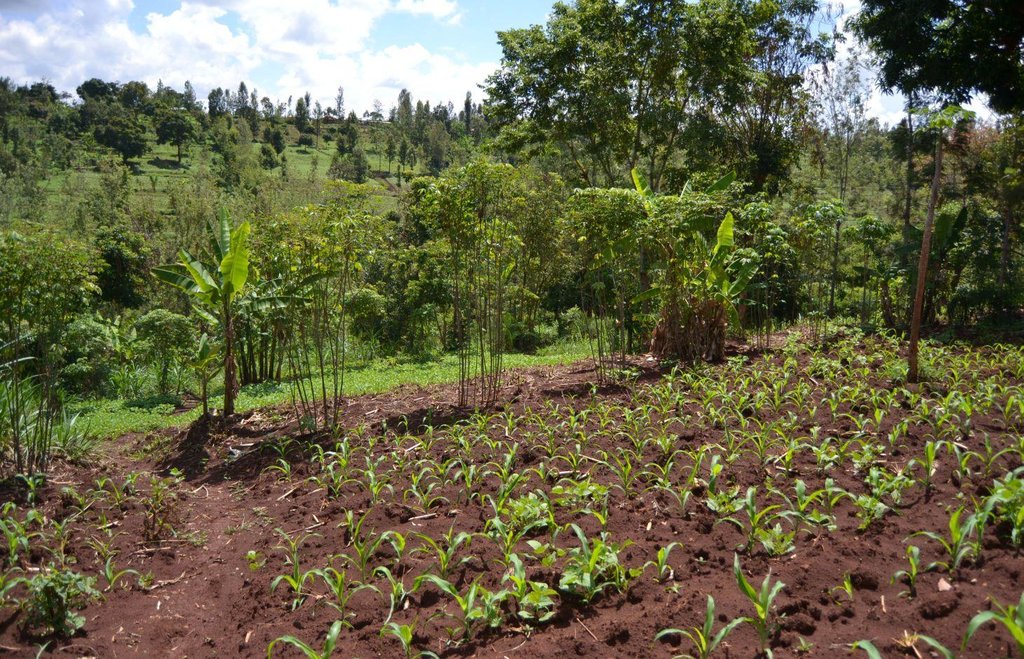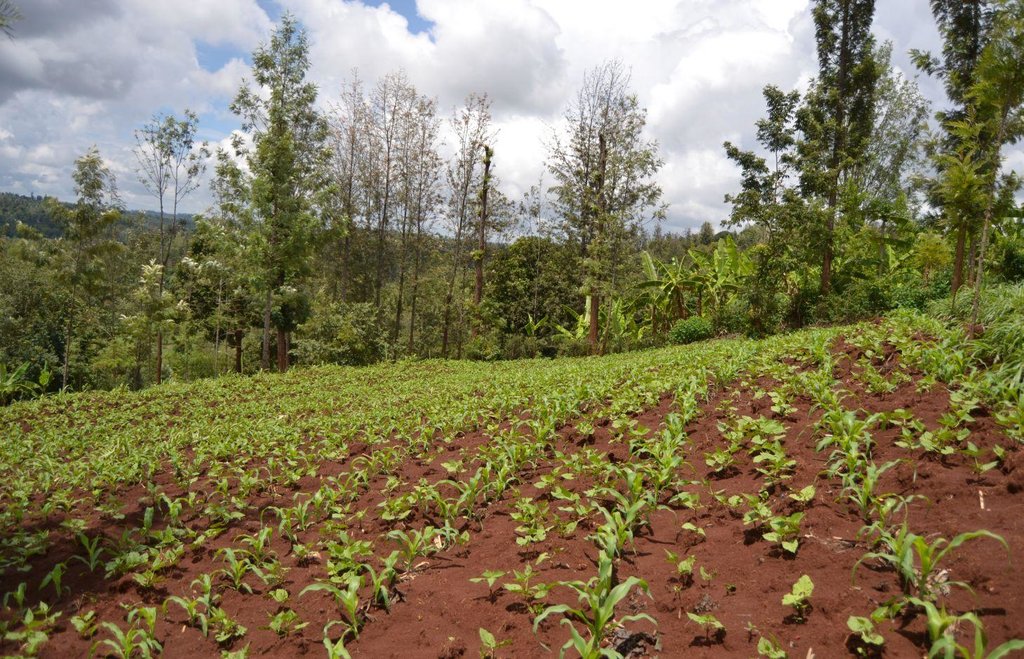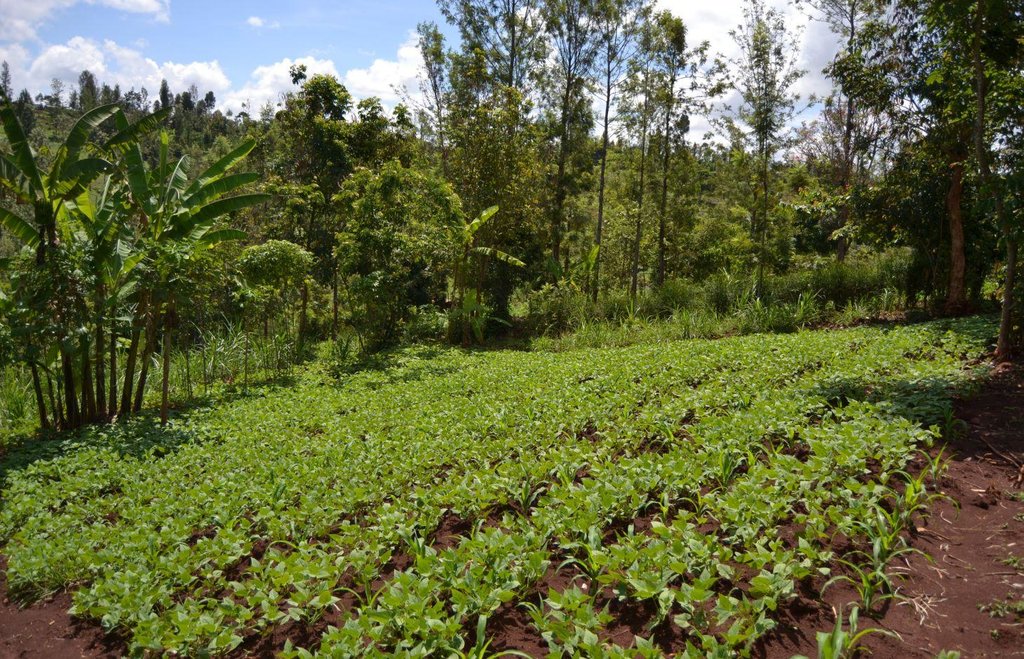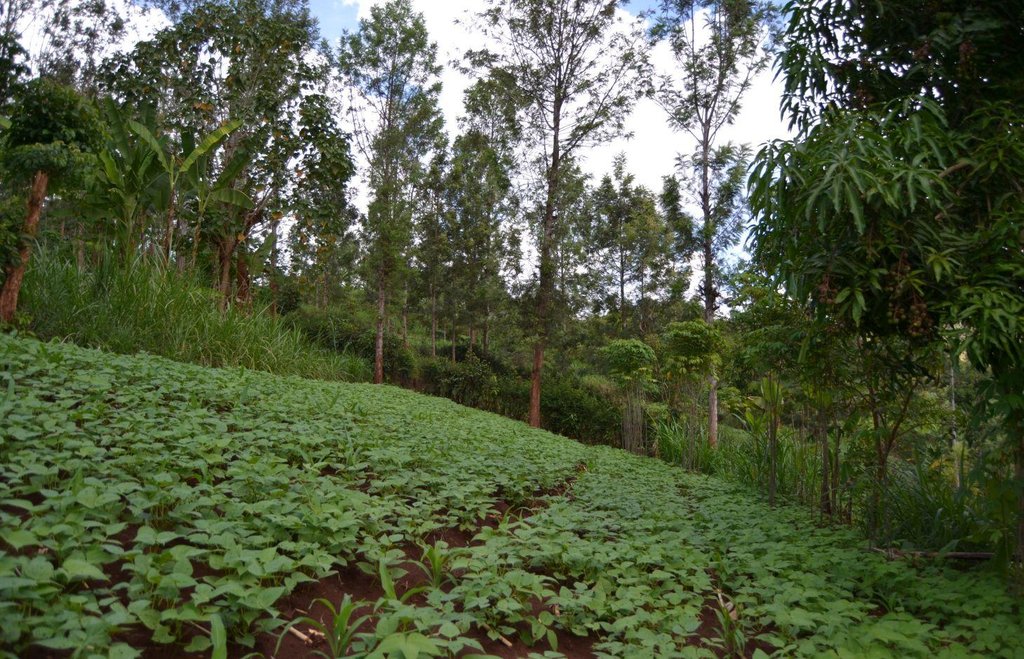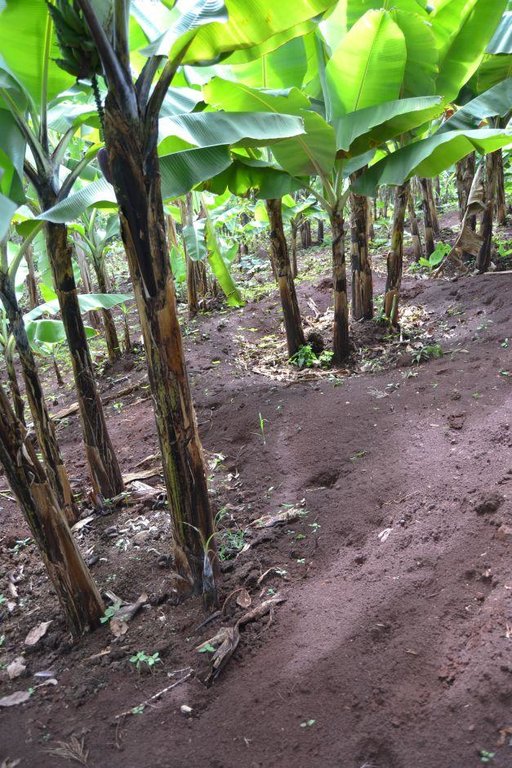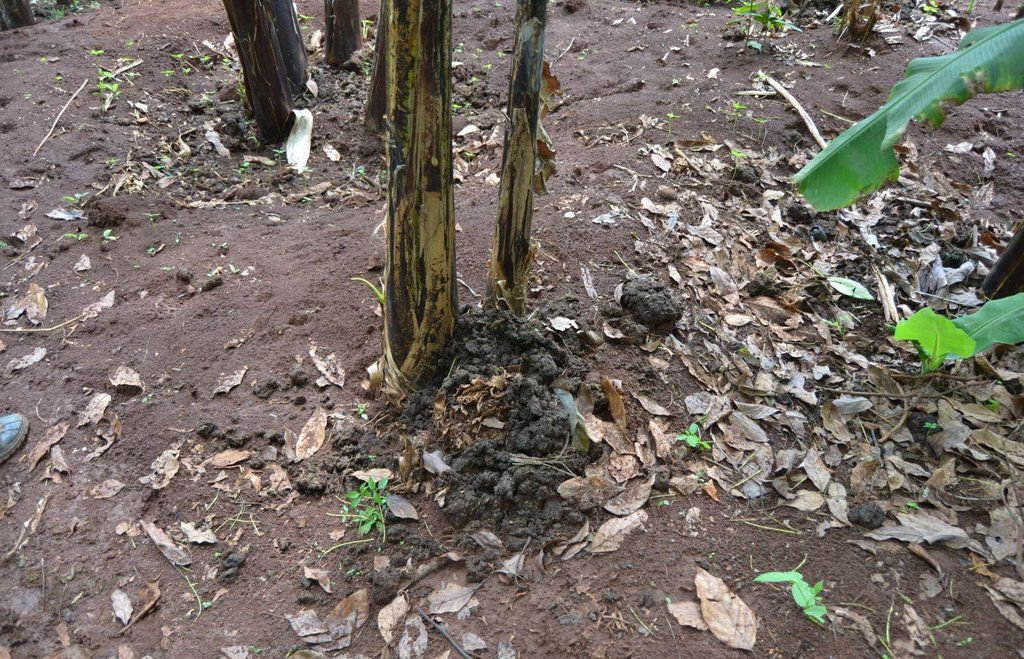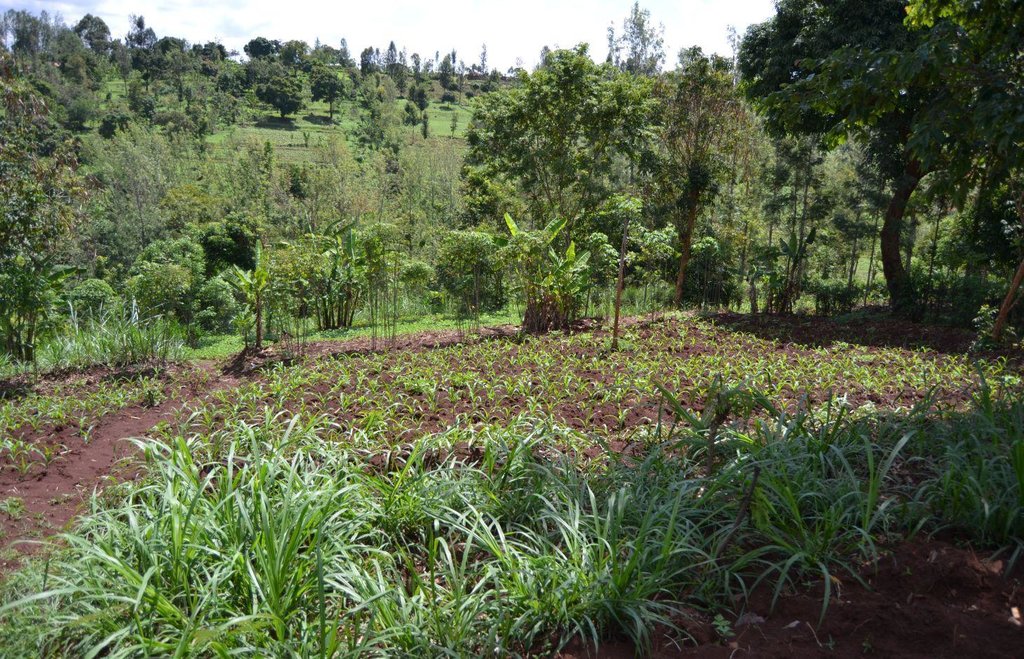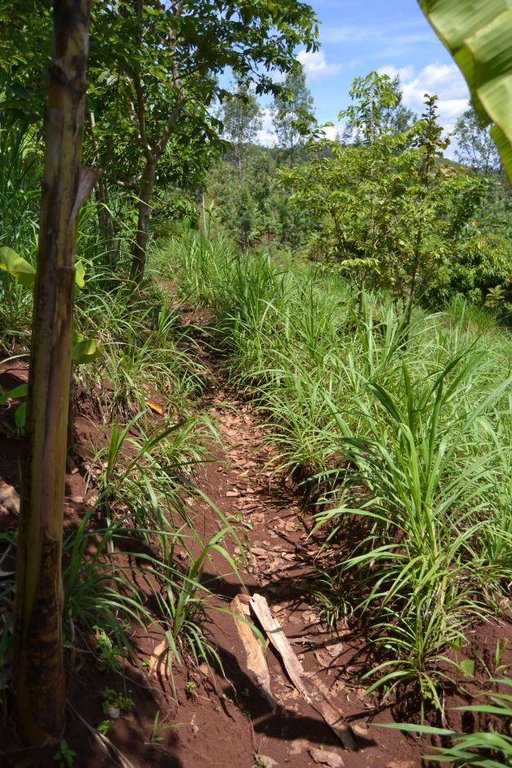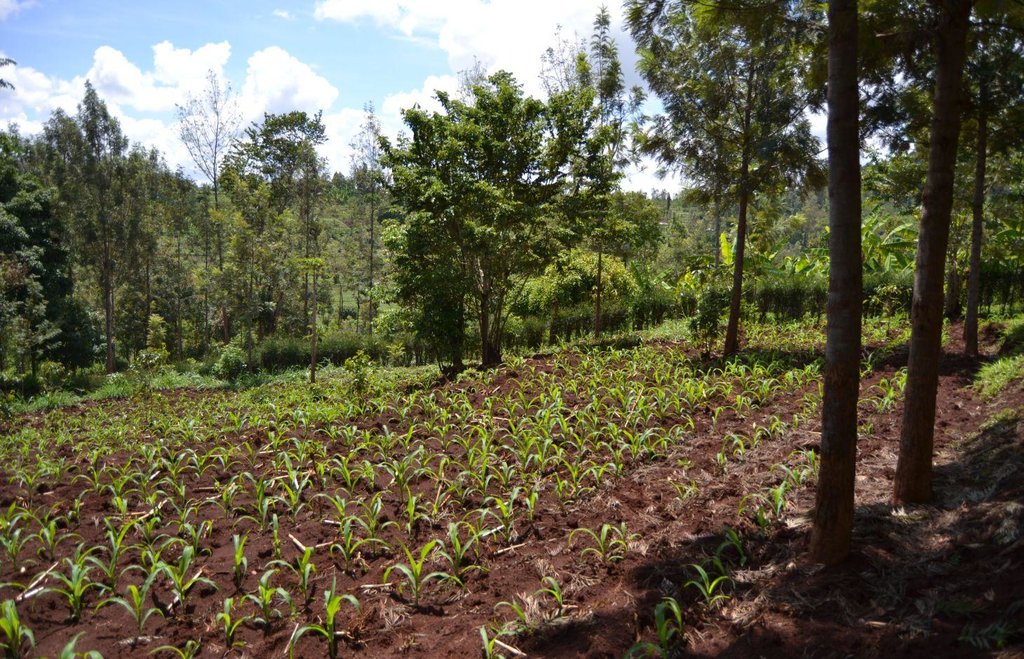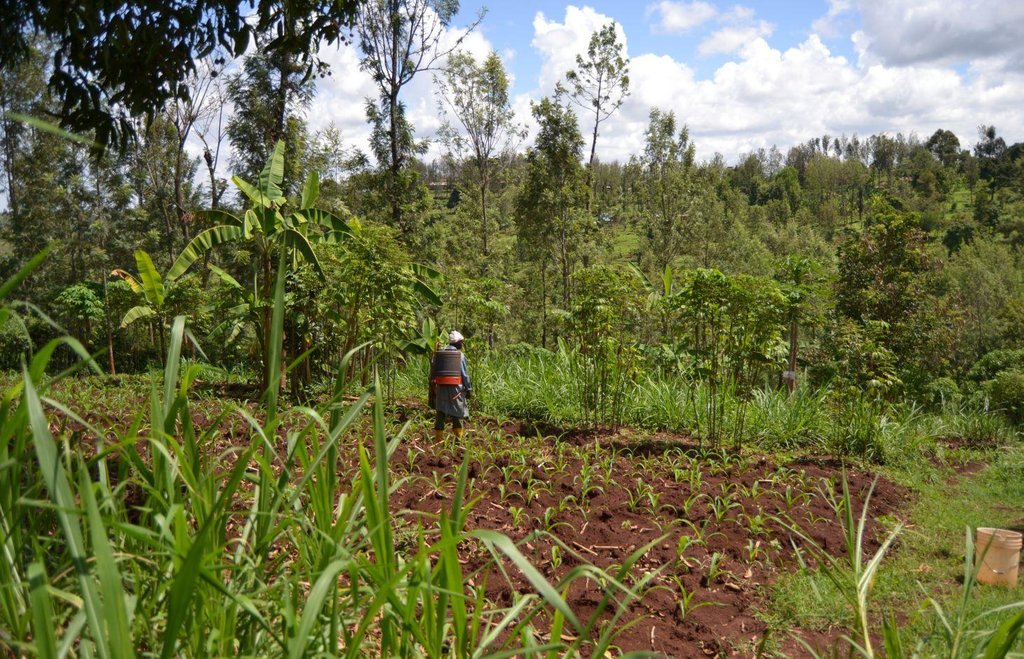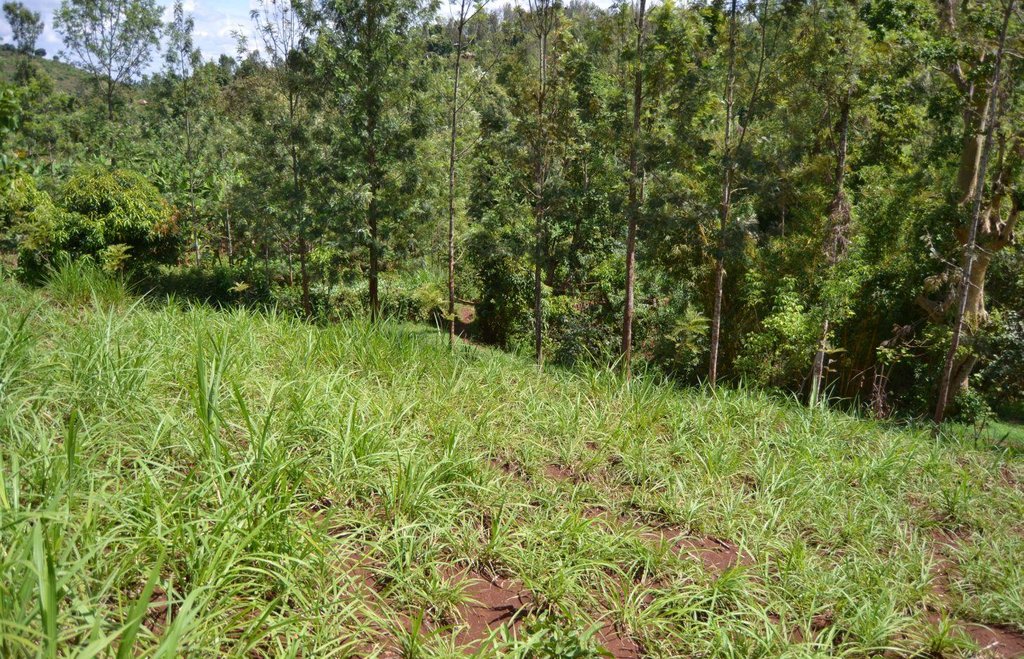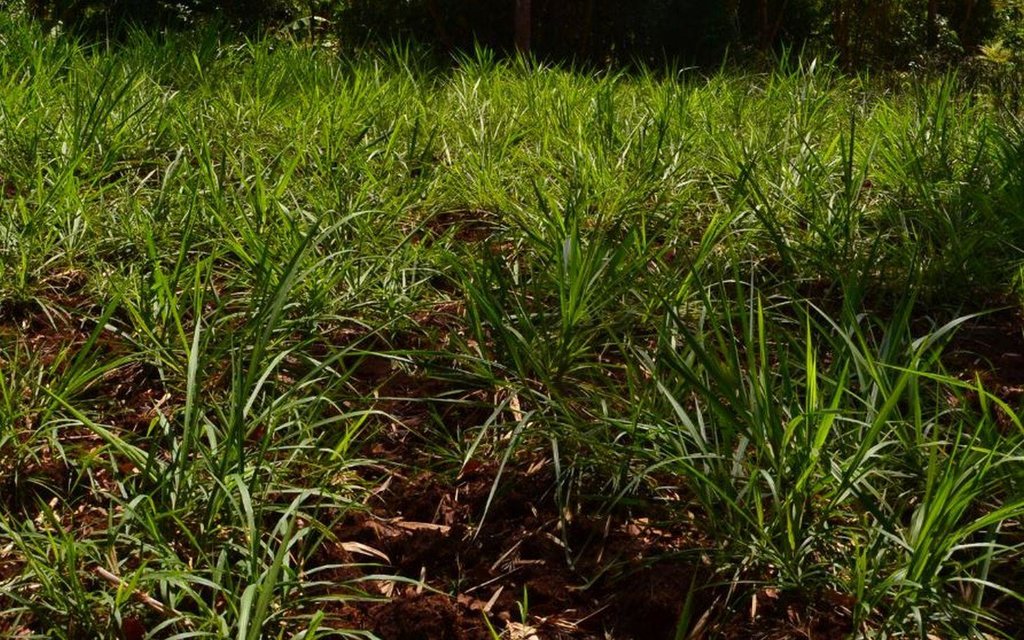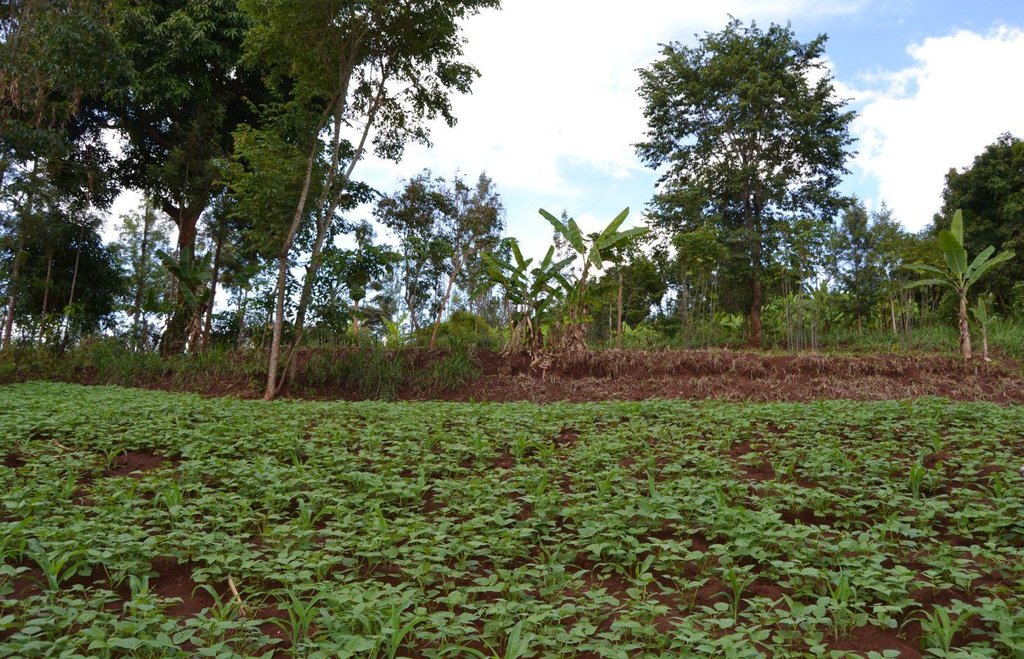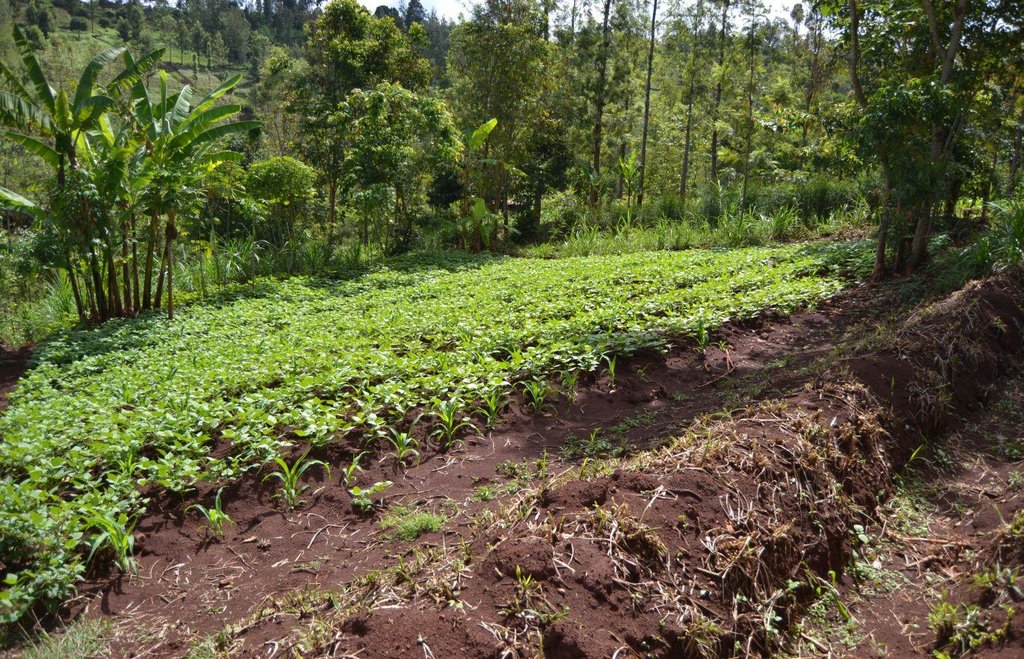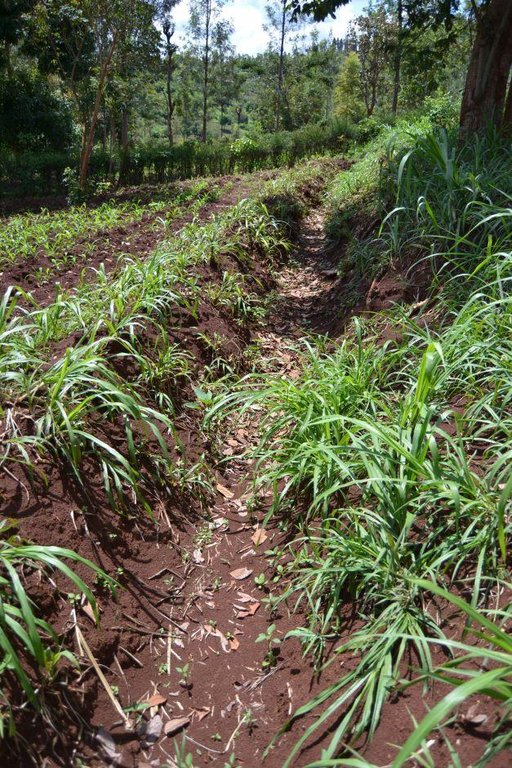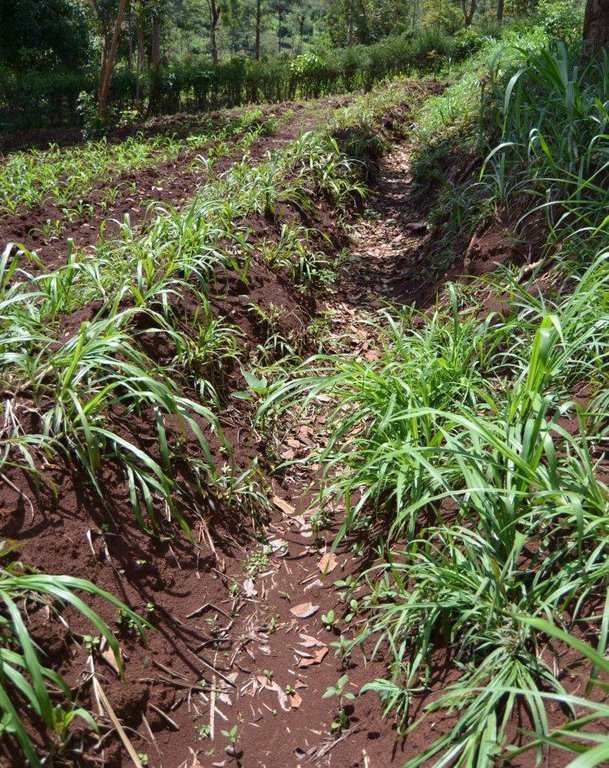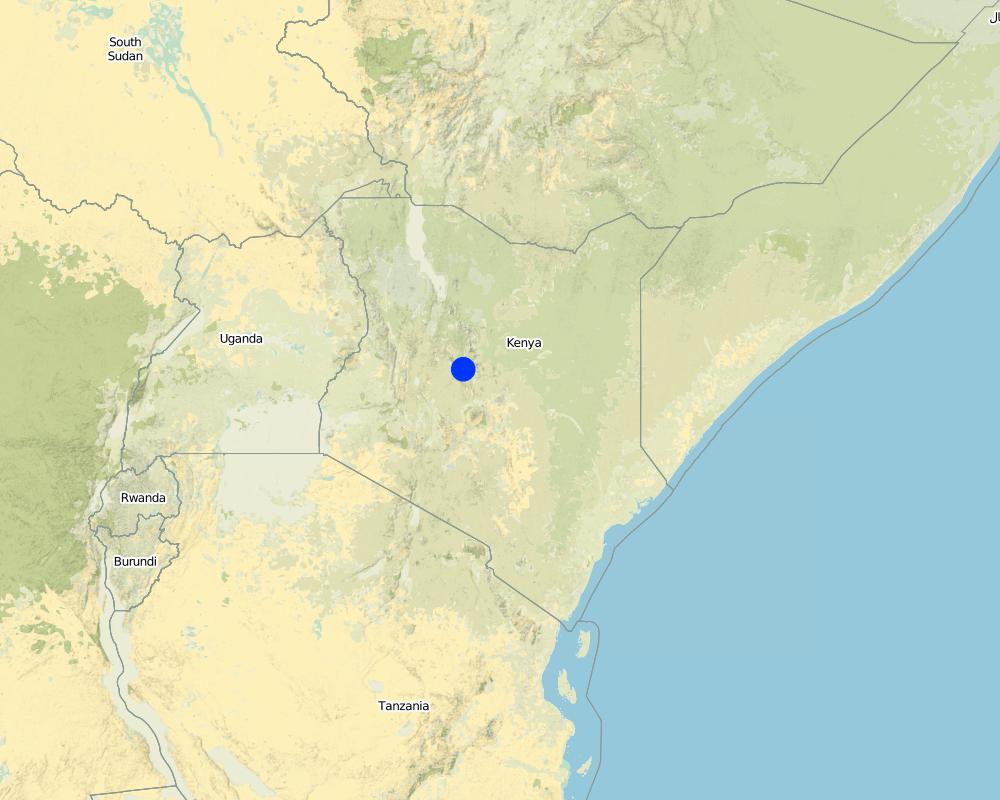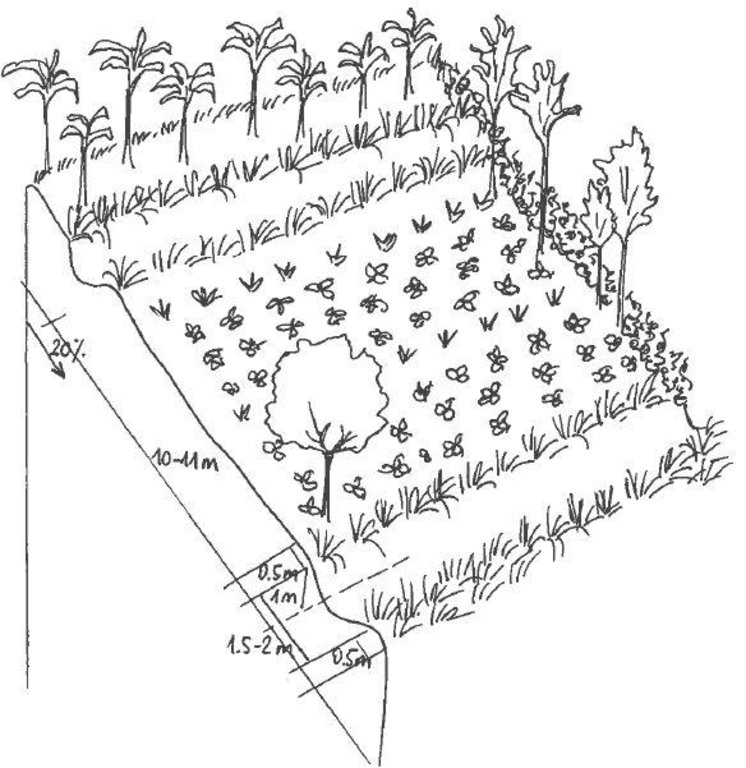Agroforestry system (intercropping beans/maize) with contour ditches, strips of Napier grass, manure and organic fertilizers. [Kenia]
- Creación:
- Actualización:
- Compilador: Laura D'Aietti
- Editor: –
- Revisores: Alexandra Gavilano, Fabian Ottiger
technologies_1146 - Kenia
- Resumen completo en PDF
- Resumen completo en PDF para imprimir
- Resumen completo en el navegador
- Resumen completo (sin formato)
- Agroforestry system (intercropping beans/maize) with contour ditches, strips of Napier grass, manure and organic fertilizers.: 28 de diciembre de 2016 (inactive)
- Agroforestry system (intercropping beans/maize) with contour ditches, strips of Napier grass, manure and organic fertilizers.: 5 de junio de 2017 (inactive)
- Agroforestry system (intercropping beans/maize) with contour ditches, strips of Napier grass, manure and organic fertilizers.: 7 de mayo de 2019 (public)
Visualizar secciones
Expandir todo Colapsar todos1. Información general
1.2 Detalles de contacto de las personas de referencia e instituciones involucradas en la evaluación y la documentación de la Tecnología
Persona(s) de referencia clave
Especialista MST:
Nyamu Joseph
WRUA Sabasaba
Kenia
1.3 Condiciones referidas al uso de datos documentados mediante WOCAT
El compilador y la/s persona(s) de referencia claves aceptan las condiciones acerca del uso de los datos documentados mediante WOCAT:
Sí
2. Descripción de la Tecnología MST
2.1 Breve descripción de la Tecnología
Definición de la Tecnología:
The technology is a combination of agricultural (e.g. intercropping, manure/compost/mulching), vegetative (e.g. Napier grass strips, trees planting) and structural (e.g. ditches) measures which aim to maximise the overall land yield in a sustainable manner (e.g. reducing soil erosion and increasing soil quality).
2.2 Descripción detallada de la Tecnología
Descripción:
The Agroforestry system combines trees plantation (Bananas, Grevillea and Avocados) for fruits and timber collection with cereal crop, maize (Zea mays). Indeed, in order to increase yields, strip intercropping is practiced: cereal crop (maize) is grown in association with pulse (food legumes): beans. Instead of using expensive commercial fertilizers, beans could facilitate maize growth due to the possible transfer of N during growth or after incorporation of the legume biomass, during the growth period of the cereal (Sangakkara et al., 2003). Furthermore, soil quality (e.g. soil structure) is improved because of the increased amount of humus and organic matter and a better soil cover helps in preventing splash erosion and increase soil moisture content and therefore fertility. Indeed, beans have a beneficial impact for weed control (probably due to the shadow effects) and soil moisture content (Worfswinkel, undated; Odhiambo and Ariga, 2001). Planting different crops helps to diversify production and family food supply. Concerning SWC, hillside ditches have been created at the top of each 'terrace' and trees are also planted nearby and Cassava (a drought resistant plant) at the bottom. Manure/compost and organic fertilizers are supplied regularly both on maize/grass (twice a year) and Bananas (once), as good soil management practice. A higher level of organic matter in the soil indicates reduced bulk density, improved soil structure, aeration and higher water holding capacity (Olabode et al., 2007), which altogether improve the physical, chemical and biological properties of the soil (Haering and Evanylo, 2005). Bananas are planted in lines in the upper part of the land. The ditches, large 1m are excavated along the contour; they break slope into shorter segments 11 m long to intercept surface runoff. Ditches also help to prevent soil erosion and to avoid that nutrients and organic matter flow easily downwards into the river, instead they fall into the ditch. A live barrier of Napier grass is present above and below the edge of the five ditches, in two lines, to capture sediments and stabilize the structure, thus it is adequately protected. To conclude, a small area of the land is used to plant Napier grass only for fodder for grazing
Purpose of the Technology: Maize and beans are cultivated for home consumption while Avocados and Bananas are planted for economic (commercial) purposes. Fruits are sold out to the middle-men directly from the house (not at the market), to reduce costs (e.g. transport) and time. Avocados are sold at about 2.5/3 Ksh and Bananas at 200 Ksh. Grevillea trees are considered as saving, and sold out for timber production when the farmer is in need of cash, earning between 800 up to 1500 Ksh, depending on the size-lenght of the tree and the costs for cutting-transportation (e.g. machine operator). In general the selling of timber occurs per feet (running feet). ‘Whole” or standing tree is the preferred mode of selling trees from farms. Negotiation on sales is per tree ‘standing on farm’, with no processing or conversion. Buyers cut and cross cut, and carry timber from farms. Branches and slabs resulting from timber recoveries are left with the farmer depending on price negotiation; if the buyer carries these products then the price of the tree is adjusted upwards (Carsan and Holding , 2006; Holding et al., undated). Furthermore, the farmer underlined how 'bad prunings' at the top of the trees cause holes inside the trunks and thus a higher risk of fungi attacks and other diseases. The majority of the trees are planted along the boundaries of the land, for demarcation and only few are 'dispersed' on the cropland, to avoid excess of shadow to the cereal crop
Establishment / maintenance activities and inputs: High initial input to construct ditches and planting crop; manure also requires regular work: feeding cows and collect droppings and distribute them twice during the year, also over Napier grass. Dry planting is the preferred practice and the seeds are soaked the night before planting; this practice is advisable especially when the growing period is very short (Schmidt et al., 1983); organic fertilizers are applied over maize after 1 week and during the growing period (after about 18 days). Further maintenance is necessary after every rainy season to remove the sediments accumulated into the ditch and for pruning Grevillea, every three seasons. As mentioned above, pruning requires skills and knowledge to avoid plant diseases and labour is expensive because it is high risk work. The farmer trees plantation account for: 15 Avocados (from 4 seedlings), 100 Bananas (from cutting new suckers) and 50 Grevillea trees
Natural / human environment: The area is characterized by rolling-hilly slope and highly exposed to erosion and land degradation: planting trees protect the soil from nutrients leaching and create a litter which reduces evaporation during dry seasons. Concerning the variety of the trees, (e.g. Avocado) the farmer by grafting with better quality branches, improve the quality of the stock trees with certified variesties: out of 4 seedlings of Avocado (10 Ksh each), he has now 15 seedlings of the better (certified) variety called HASS, which performs well at 800-2100 m asl with well distributed annual rainfall of 1000-1200 mm (Youth Agro-environmental initiative website)
2.3 Fotografías de la Tecnología
2.5 País/ región/ lugares donde la Tecnología fue aplicada y que se hallan comprendidos por esta evaluación
País:
Kenia
Región/ Estado/ Provincia:
Central
Especifique más el lugar :
Muthithi location, Kagurumo sublocation
Especifique la difusión de la Tecnología:
- distribuida parejamente sobre un área
Si la Tecnología se halla difundida homogéneamente a lo largo de un área, especifique el área que cubre (en km2):
0,008
Si se desconoce el área precisa, indique el área aproximada cubierta:
- < 0.1 km2 (10 ha)
Comentarios:
Total area covered by the SLM Technology is 0.008 km2.
GATWAMIKWA village
Map
×2.6 Fecha de la implementación
Si no se conoce el año preciso, indique la fecha aproximada:
- hace menos de 10 años (recientemente)
2.7 Introducción de la Tecnología
Especifique cómo se introdujo la Tecnología:
- mediante la innovación de usuarios de tierras
Comentarios (tipo de proyecto, etc.):
Since the year 2000 the farmer adopted SWC practices in respond to the prolonged degraded situation of the land and its low yields.
3. Clasificación de la Tecnología MST
3.2 Tipo(s) actuales de uso de la tierra donde se aplica la Tecnología
Mezcla de tipos de uso de tierras dentro de la misma unidad de tierras: :
Sí
Especifique el uso combinado de tierras (cultivos/ pastoreo/ árboles):
- Agro-silvopastoralismo

Tierras cultivadas
- Cosecha anual
- Cultivos perennes (no leñosos)
- Cosecha de árboles y arbustos
Cosechas anuales - Especifique cultivos:
- cereales - maíz
- cultivos para forraje - pastos
- leguminosas y legumbres - frijoles
Cultivos perennes (no maderables) - Especifique cultivos:
- banana/plátano/abacá
Cultivos de matorrales y arbustos - Especifique cultivos:
- avocado
Número de temporadas de cultivo por año:
- 2
Especifique:
Longest growing period in days: 122Longest growing period from month to month: from about March to JuneSecond longest growing period in days: 61Second longest growing period from month to month: from about October to November
¿Se practica el intercultivo?
Sí
Si respondió que sí, especifique qué cultivos son intercultivados:
Intercropping of maize and beans: the distance from one line of maize and the other is of 1m.

Tierra de pastoreo
Pastoreo intensivo/ producción de forraje:
- Cortar y llevar/ cero pastoreo
- cows

Bosques
- Plantación de árboles, reforestación
Tipo de árbol:
- Grevillea robusta
Productos y servicios:
- Madera
- Frutos y nueces
Comentarios:
Trees/ shrubs species: Grevillea (Grevillea robusta)
Fruit trees / shrubs species: Avocados (Persea americana- Mũkorobia), Bananas (Musa sapientum- Irigũ)
Grass species: Pennisetum pyramidalis (Napier grass or elephant grass)
Main crop: Maize (Zea mays) and beans
Main animal species and products: Cut-and-carry/ zero grazing: Fodder is provided to animals (2 cows) confined to a stall.
Major land use problems (compiler’s opinion): Sheet erosion with consequent nutrient leaching which could drain into the river.
Major land use problems (land users’ perception): Loss of soil fertility.
Grazingland comments: Fig. 10 Annex 3
Plantation forestry: Yes
Type of grazing system comments: Fig. 10 Annex 3
Livestock density: < 1 LU/km2
3.4 Provisión de agua
Provisión de agua para la tierra donde se aplica la Tecnología:
- de secano
3.6 Medidas MST que componen la Tecnología

medidas agronómicas
- A1: vegetación/ cubierta del suelo
- A2: materia orgánica/ fertilidad del suelo
- A3: Tratamiento de superficie del suelo

medidas vegetativas
- V1: Cubierta de árboles y arbustos
- V2: Pastos y plantas herbáceas perennes

medidas estructurales
- S4: Acequias niveladas, fosas
Comentarios:
Main measures: vegetative measures, structural measures
Secondary measures: agronomic measures
Type of agronomic measures: mulching, legume inter-planting, manure / compost / residues
Type of vegetative measures: aligned: -graded strips *<sup>3</sup>
3.7 Principales tipos de degradación del suelo encarados con la Tecnología

erosión de suelos por agua
- Wt: pérdida de capa arable/ erosión de la superficie

deterioro químico del suelo
- Cn: reducción de la fertilidad y contenido reducido de la materia orgánica del suelo (no ocasionados por la erosión)

degradación del agua
- Hq: reducción de la calidad de subterráneas
Comentarios:
Main causes of degradation: soil management (Poor soil management practices.), deforestation / removal of natural vegetation (incl. forest fires) (Poor vegetation cover, mainly herbaceous), disturbance of water cycle (infiltration / runoff) (Steep area (runoff)), Heavy / extreme rainfall (intensity/amounts) (Especially during wet seasons: March-June and October-November), education, access to knowledge and support services (Limited knowledge and training on SWC practices), governance / institutional (Limited or not adequate support)
Secondary causes of degradation: other natural causes (avalanches, volcanic eruptions, mud flows, highly susceptible natural resources, extreme topography, etc.) specify (From gentle to hilly slope), land tenure (Previous poor management SWC measures, especially in the upper areas)
3.8 Prevención, reducción o restauración de la degradación del suelo
Especifique la meta de la Tecnología con relación a la degradación de la tierra:
- prevenir la degradación del suelo
- reducir la degradación del suelo
4. Especificaciones técnicas, actividades de implementación, insumos y costos
4.1 Dibujo técnico de la Tecnología
Especificaciones técnicas (relacionadas al dibujo técnico):
Agroforestry system, which covers an area of 2 acre. The plot is bordered by Euphorbia tirucalli (Kariaria, milk bush) and Grevillea trees. The ditches are characterized by barriers of Napier grass. Intercropping of maize and beans: the distance from one line of maize and the other is of 1m.
Technical knowledge required for land users: moderate
Main technical functions: control of dispersed runoff: retain / trap, control of dispersed runoff: impede / retard, reduction of slope angle, reduction of slope length, improvement of ground cover, increase of infiltration, increase / maintain water stored in soil, water harvesting / increase water supply, sediment retention / trapping, sediment harvesting
Secondary technical functions: improvement of topsoil structure (compaction), stabilisation of soil (eg by tree roots against land slides), increase in organic matter, increase in nutrient availability (supply, recycling,…), improvement of water quality, buffering / filtering water, increase of biomass (quantity)
Mulching
Material/ species: Organic residues around Banana trees
Quantity/ density: undefined
Legume inter-planting
Quantity/ density: 4 kg
Manure / compost / residues
Material/ species: Leftovers and manure from two cows
Quantity/ density: 8 tonnes
Remarks: (for 1 year). The mix of organic material is left decomposed in a big hole.
Agronomic measure: organic fertilizers
Material/ species: Acid humic and N, P, K, microelements (Biodeposit Elixir: small bags (sachets) of 12 ml)
Remarks: 5 bags (1×12 litre), applied only on maize
Aligned: -graded strips
Vegetative material: T : trees / shrubs, F : fruit trees / shrubs, G : grass
Number of plants per (ha): 100 a strip
Vertical interval between rows / strips / blocks (m): few cm
Spacing between rows / strips / blocks (m): 1
Vertical interval within rows / strips / blocks (m): 0.25
Width within rows / strips / blocks (m): 1
Trees/ shrubs species: Grevillea (Grevillea robusta)
Fruit trees / shrubs species: Avocados (Persea americana- Mũkorobia), Bananas (Musa sapientum- Irigũ)
Grass species: Pennisetum pyramidalis (Napier grass or elephant grass)
Slope (which determines the spacing indicated above): 10%
If the original slope has changed as a result of the Technology, the slope today is (see figure below): 15%
Gradient along the rows / strips: 5-8%
Diversion ditch/ drainage
Spacing between structures (m): 1
Depth of ditches/pits/dams (m): 40/50
Width of ditches/pits/dams (m): 0.6/1
Slope (which determines the spacing indicated above): 5-8%
Lateral gradient along the structure: 15-20%
Autor:
D'Aietti Laura
4.2 Información general sobre el cálculo de insumos y costos
otra / moneda nacional (especifique):
Kenyan Schellings
Si fuera relevante, indique la tasa de cambio de dólares americanos a la moneda local (ej. 1 U$ = 79.9 Reales Brasileros): 1 U$ =:
85,9
Indique el costo promedio del salario de trabajo contratado por día:
2.00
4.3 Actividades de establecimiento
| Actividad | Momento (estación) | |
|---|---|---|
| 1. | Digging holes (1 feet ×1 feet) and planting trees (e.g. Grevillea trees along the boundaries and in line below the bunds of the ditches) | March (before rains), 1 year |
| 2. | Establishment of the ditches(digging ditch and creating soil bunds donward) and terracing. For 1 (in tot. are 5) : 2 p.d. * 1 day at 200 Ksh a day each. | 2 times per year |
| 3. | Digging the hole (3m×3m×1.5m) where to compost | |
| 4. | Machine to grill/mill maize leftovers (chap cutter) | |
| 5. | Purchase 2 cows | |
| 6. | Purchase generator |
Comentarios:
Life span of the machine to grill, the cows and the generator: Several years
4.4 Costos e insumos necesarios para el establecimiento
| Especifique insumo | Unidad | Cantidad | Costos por unidad | Costos totales por insumo | % de los costos cubiertos por los usuarios de las tierras | |
|---|---|---|---|---|---|---|
| Mano de obra | Digging the hole (3m×3m×1.5m) where to compost | person/days | 2,0 | 3,5 | 7,0 | 100,0 |
| Mano de obra | Digging holes (1 feet ×1 feet) and planting trees | person/days | 2,0 | 3,5 | 7,0 | 100,0 |
| Mano de obra | Establishment of the ditches (digging ditch and creating soil bunds donward) and terracing | person/days | 10,0 | 23,3 | 233,0 | 100,0 |
| Equipo | Machine to grill/mill maize leftovers (chap cutter) | piece | 1,0 | 1164,0 | 1164,0 | 100,0 |
| Equipo | Generator | piece | 1,0 | 582,0 | 582,0 | 100,0 |
| Equipo | Cow | piece | 2,0 | 349,0 | 698,0 | 100,0 |
| Material para plantas | Seedlings Grevillea | pieces | 54,0 | 0,1111 | 6,0 | 100,0 |
| Costos totales para establecer la Tecnología | 2697,0 | |||||
| Costos totales para establecer la Tecnología en USD | 31,4 | |||||
Comentarios:
Duration of establishment phase: 6 month(s)
4.5 Actividades de establecimiento/ recurrentes
| Actividad | Momento/ frequencia | |
|---|---|---|
| 1. | Prepare and apply fertilizers (organic) (See Annex 3, Fig. 9&comments) | Ferlizer application: after 1 week and 18 days, on maize only |
| 2. | Prepare manure+compost/mulch (Summary 2.1.2 QT4): Labour (to grill/mill leftovers - 300 Ksh for fuel- leftovers to prepare food for cows-3 person days) rest, the farmer by himself feed cows on daily basis (3 times in a day). Fuel: 1litre×1 day (×3 days) | compost/manure: 2 times/year in the field+grass; once on Bananas (where also added mulch) |
| 3. | Harvesting maize/beans (around Feb/March and Ag/Sept) | 2 times |
| 4. | Apply manure, mulch and compost (during March/April-long rains+Sept) just before the rains, when nutrients infiltrate into the soil with rainwater) (Summary 2.1.2 QT4) | Compost/manure: 2 times/year in the field+grass; once on Bananas (where also added mulch) |
| 5. | Tilling-soil (digging holes to plant maize/beans: 7 inches deep (17cm), spaced 1 feet (0.30 m) in contours: dry planting (before rains starts) | Twice a year, before rainy season (around March/Sept) |
| 6. | Digging planting holes and planting grass (2 persons × 3 days: 200 Ksh) | Every season (March/April and Sept/Oct) |
| 7. | Maintenance (weed control and cutting Napier grass and collecting fodder) (Fig. 11 Annex 3) | Every season (March/Sept); cutting Napier: 3/4 times in a season |
| 8. | Pruning branches and let them dry for firewood | Every 3 seasons (and when shortage of firewood) |
| 9. | Clearing the tree for selling timber (the price depends also of the use of the chainsaw (or saw) or not | When in need of cash (not regularly), not less than 5 years after planting |
| 10. | Repairing the ditches and remove excess of soil/leaves accumulated during the rainy season | After rains (every season) |
4.6 Costos e insumos necesarios para actividades de mantenimiento/ recurrentes (por año)
| Especifique insumo | Unidad | Cantidad | Costos por unidad | Costos totales por insumo | % de los costos cubiertos por los usuarios de las tierras | |
|---|---|---|---|---|---|---|
| Mano de obra | Prepare and apply fertilizers (organic) | person/days | 2,0 | 2,0 | 4,0 | 100,0 |
| Mano de obra | Prepare manure+compost/mulch | person/days | 3,0 | 2,0 | 6,0 | 100,0 |
| Mano de obra | Digging planting holes and planting grass | person/days | 6,0 | 2,0 | 12,0 | 100,0 |
| Mano de obra | Maintenance (weed control and cutting Napier grass and collecting fodder) | person/days | 5,0 | 12,0 | 60,0 | 100,0 |
| Equipo | Fuel | l | 3,0 | 1,0 | 3,0 | 100,0 |
| Material para plantas | Seedlings grass (per ha) | pieces | 100,0 | |||
| Fertilizantes y biocidas | Organic fertilizer (Biodeposit Elixir) from Thika | ml | 12,0 | 1,0 | 12,0 | 100,0 |
| Otros | Labour: Pruning branches and let them dry for firewood | person/days | 1,0 | 4,0 | 4,0 | 100,0 |
| Otros | Labour: Clearing the tree for selling timber | person/days | 1,0 | 7,0 | 7,0 | 100,0 |
| Otros | Labour: Repairing the ditches and remove excess of soil/leaves accumulated during the rainy season | person/days | 2,0 | 2,0 | 4,0 | 100,0 |
| Indique los costos totales para mantenecer la Tecnología | 112,0 | |||||
| Costos totales para mantener la Tecnología en USD | 1,3 | |||||
Comentarios:
Machinery/ tools: the farmer prefers to use fork djembe then just the normal djembe (because it removes better the soil); panga and hoes, shovel, fork djembe, panga, saw, shovels
The costs has been computed during the period of the field visit and it include all the costs for the different structures: agronomic, vegetative and structural measures for 2 acre of land and summarized for 1 year period.
4.7 Factores más determinantes que afectan los costos:
Describa los factores más determinantes que afectan los costos:
The main environmental constrain is water, in particular during dry season; An important cost is labour required to maintain all the SWC measures.
5. Entorno natural y humano
5.1 Clima
Lluvia anual
- < 250 mm
- 251-500 mm
- 501-750 mm
- 751-1,000 mm
- 1,001-1,500 mm
- 1,501-2,000 mm
- 2,001-3,000 mm
- 3,001-4,000 mm
- > 4,000 mm
Zona agroclimática
- Sub-húmeda
Thermal climate class: subtropics. June, July and August
5.2 Topografía
Pendientes en promedio:
- plana (0-2 %)
- ligera (3-5%)
- moderada (6-10%)
- ondulada (11-15%)
- accidentada (16-30%)
- empinada (31-60%)
- muy empinada (>60%)
Formaciones telúricas:
- meseta/ planicies
- cordilleras
- laderas montañosas
- laderas de cerro
- pies de monte
- fondo del valle
Zona altitudinal:
- 0-100 m s.n.m.
- 101-500 m s.n.m.
- 501-1,000 m s.n.m
- 1,001-1,500 m s.n.m
- 1,501-2,000 m s.n.m
- 2,001-2,500 m s.n.m
- 2,501-3,000 m s.n.m
- 3,001-4,000 m s.n.m
- > 4,000 m s.n.m
5.3 Suelos
Profundidad promedio del suelo:
- muy superficial (0-20 cm)
- superficial (21-50 cm)
- moderadamente profunda (51-80 cm)
- profunda (81-120 cm)
- muy profunda (>120 cm)
Textura del suelo (capa arable):
- mediana (limosa)
Materia orgánica de capa arable:
- baja (<1%)
5.4 Disponibilidad y calidad de agua
Agua subterránea:
> 50 m
Disponibilidad de aguas superficiales:
mediana
Calidad de agua (sin tratar):
agua potable de buena calidad
5.5 Biodiversidad
Diversidad de especies:
- mediana
5.6 Las características de los usuarios de la tierra que aplican la Tecnología
Ingresos no agrarios:
- > 50% de todo el ingreso
Nivel relativo de riqueza:
- rico
Individuos o grupos:
- individual/ doméstico
Nivel de mecanización:
- trabajo manual
Indique otras características relevantes de los usuarios de las tierras:
Population density: 10-50 persons/km2
Annual population growth: 2% - 3%
Off-farm income specification: The farmer is rich because he owns 3 acre of land and livestock, assets (electricity) which are above the average standards of the community. The farmer is retired from an accountancy service position several years ago.
Market orientation of production system: subsistence (self-supply), subsistence (self-supply), commercial/ market
5.7 Área promedio de la tierra usada por usuarios de tierra que aplican la Tecnología
- < 0.5 ha
- 0.5-1 ha
- 1-2 ha
- 2-5 ha
- 5-15 ha
- 15-50 ha
- 50-100 ha
- 100-500 ha
- 500-1,000 ha
- 1,000-10,000 ha
- > 10,000 ha
5.8 Tenencia de tierra, uso de tierra y derechos de uso de agua
Tenencia de tierra:
- individual, con título
Derechos de uso de tierra:
- individual
Derechos de uso de agua:
- acceso abierto (no organizado)
Comentarios:
Water use rights depend on the use: open access for drinking and domestic uses.
5.9 Acceso a servicios e infraestructura
salud:
- pobre
- moderado
- bueno
educación:
- pobre
- moderado
- bueno
asistencia técnica:
- pobre
- moderado
- bueno
empleo (ej. fuera de la granja):
- pobre
- moderado
- bueno
mercados:
- pobre
- moderado
- bueno
energía:
- pobre
- moderado
- bueno
caminos y transporte:
- pobre
- moderado
- bueno
agua potable y saneamiento:
- pobre
- moderado
- bueno
servicios financieros:
- pobre
- moderado
- bueno
6. Impactos y comentarios para concluir
6.1 Impactos in situ demostrados por la Tecnología
Impactos socioeconómicos
Producción
producción de cultivo
producción de madera
Ingreso y costos
gastos en insumos agrícolas
ingreso agrario
Impactos socioculturales
situación de grupos en desventaja social y económica
Impactos ecológicos
Ciclo de agua/ escurrimiento de sedimento
escurrimiento superficial
evaporación
Suelo
humedad del suelo
cubierta del suelo
pérdida de suelo
Biodiversidad: vegetación, animales
biomasa/ sobre suelo C
6.2 Impactos fuera del sitio demostrados por la Tecnología
disponibilidad de agua
capacidad de amortiguación/ filtrado
6.3 Exposición y sensibilidad de la Tecnología al cambio climático gradual y a extremos relacionados al clima/ desastres (desde la percepción de los usuarios de tierras)
Cambio climático gradual
Cambio climático gradual
| Estación | Incremento o reducción | ¿Cómo es que la tecnología soporta esto? | |
|---|---|---|---|
| temperatura anual | incrementó | no se sabe |
Extremos (desastres) relacionados al clima
Desastres climatológicos:
| ¿Cómo es que la tecnología soporta esto? | |
|---|---|
| tormenta de lluvia local | bien |
| tormenta de viento | bien |
Desastres climatológicos
| ¿Cómo es que la tecnología soporta esto? | |
|---|---|
| sequía | no muy bien |
Desastres hidrológicos
| ¿Cómo es que la tecnología soporta esto? | |
|---|---|
| inundación general (río) | bien |
Otras consecuencias relacionadas al clima
Otras consecuencias relacionadas al clima
| ¿Cómo es que la tecnología soporta esto? | |
|---|---|
| periodo reducido de crecimiento | no se sabe |
6.4 Análisis costo-beneficio
¿Cómo se comparan los beneficios con los costos de establecimiento (desde la perspectiva de los usuarios de tierra)?
Ingresos a corto plazo:
ligeramente negativo
Ingresos a largo plazo:
ligeramente positivo
¿Cómo se comparan los beneficios con los costos de mantenimiento/ recurrentes (desde la perspectiva de los usuarios de tierra)?
Ingresos a corto plazo:
ligeramente positivo
Ingresos a largo plazo:
positivo
6.5 Adopción de la Tecnología
Comentarios:
100% of land user families have adopted the Technology without any external material support
There is a moderate trend towards spontaneous adoption of the Technology
6.7 Fuerzas/ ventajas/ oportunidades de la Tecnología
| Fuerzas/ ventajas/ oportunidades desde la perspectiva del usuario de la tierra |
|---|
| Better yields thanks to the intercropping measures taken. |
| Fuerzas/ ventajas/ oportunidades desde la perspectiva del compilador o de otra persona de referencia clave |
|---|
|
Intercropping is a commonly known practice which improves the overall conditions of the soil and provide better yields. How can they be sustained / enhanced? Besides 'companion planting' there are plants which can be grown as forerunner plants (Storey, 2002). Depending also on the type of soil, attention could be given to some sps. which accumulate concentration of e.g. mineral accumulators, phosporus, potassium, calcium, silica and sulphur . Another way to perhaps enhance the yields is relay intercropping. It is undersowing the next crop into the present crop, so that the present crop is a nurse crop and time and water is saved in the establishment of the following crop (Storey, 2002) Green manure as a way to add organic nutrients and combine more than one green manure and rotate, both legume (e.g. cowpeas, soybeans, annual sweet clover, vetch, sesbania, and velvet beans ) and not legume (e.g. sudangrass, millet, sorghum, and buckwheat). |
|
Agroforestry (Dispersed trees on cropland): The technology is simple to adopt and improves a sustainable land management as well as diversification of income sources and food supply. How can they be sustained / enhanced? It could be implemented by increasing the number of trees planted (e.g. along the boundaries) and with sps. characterised by deeper root systems, to avoid further water competition. More Avocadoe trees could increase the opportunities for the farmer to be part of a CBO (Community Based Organization) addressed to marketing of Avocadoes for oil production. This could help the farmer to earn more money and invest more in SWC implementation and new methods, in the long run. The option of alley cropping (hedgerow Intercropping) with leguminous plants e.g. Sesbanian sesban (Ramachandran Nair-ICRAF, 1993) could be considered as another option. |
|
Napier grass has very good properties in holding soil; also for ditch stabilization and fodder production How can they be sustained / enhanced? Other herbaceous vegetation could be also planted in the field: e.g. Tithonia diversifolia (Mexican sunflower), an excellent (high quality-N, P, K concentration) green manure /nutrient release and medicinal plant, or could be also used as a major component of compost manure. It is an annual weed that can be used for several purposes: fodders, poultry feed, fuel, compost, land demarcation, soil erosion, building materials, shelter for poultry. It is characterized by adaptability to different environment, rapid growth, fast rate of decomposition. Nevertheless, there is the need to ascertain the extent to which this weed sps. could be used for soil improvement and to determine the best mode of application of the weed sps., (Olabode et al., 2007, Olubukola et al., 2013) and the fact that is a invasive weed (with an aggressive growth) it requires a good knowledge in the land management and weed control. |
| The attention to certified varieties give also more value to the production itself and at market level: an increase of the bargaining power creates more opportunities for better income and chances to explore new and bigger markets, (e.g. Avocados for oil production ). |
6.8 Debilidades/ desventajas/ riesgos de la Tecnología y formas de sobreponerse a ellos
| Debilidades/ desventajas/ riesgos desde la perspectiva del compilador o de otra persona de referencia clave | ¿Cómo sobreponerse a ellas? |
|---|---|
| The technologies in place require maintenance and monitoring, especially during rainy seasons | Eventually subsides or be part of a CBO's (Community Based Organizations) or SHG (Self Help Groups); Still the measures already in place could be improved: diversification of trees (e.g. indigenous) and trainings (e.g. pruning etc) could help the farmer in avoiding tree diseases and allocate more efficiently resources. |
| The amount of work required to carry out all the activities is too much. |
7. Referencias y vínculos
7.1 Métodos/ fuentes de información
7.2 Vínculos a las publicaciones disponibles
Título, autor, año, ISBN:
Holding C., Carsan S., Njuguna P., 2004. Smallholder Timber Marketing: A Kenyan Experience. FAO/ICRAF/GoK multi-stakeholder programme. International Workshop on small holder timber production.
Título, autor, año, ISBN:
Odhiambo G.D. and Ariga E. S., 2001. Effect of intercropping maize and beans on Striga incidence and grain yield. Seventh Eastern and Southern Africa Regional Maize Conference. 11th -15 th February, 2001. pp. 183-186.
Título, autor, año, ISBN:
Olabode O.S., Sola O., Akanbi W.B., Adesina G.O., Babajide P.A., 2007. Evaluation of Tithonia diversifolia (Hemsl.) A Gray for Soil Improvement. World Journal of Agricultural Sciences 3 (4): 503-507.
¿Dónde se halla disponible? ¿Costo?
http://www.idosi.org/wjas/wjas3(4)/15.pdf
Título, autor, año, ISBN:
Olubukola S. A., Aderemi Ojo Ezekiel-Adewoyin O., Dorcas Tinuke D., Akintoye Henry, 2010. Comparing the use of Tithonia diversifolia and Compost as soil amendments for growth and yield of Celosia argentea. New York Science Journal 3 (6).
¿Dónde se halla disponible? ¿Costo?
http://www.sciencepub.net/newyork/ny0306/20_2680_ny0306_133_138.pdf
Título, autor, año, ISBN:
Ramachandran Nair P. K., 1993. An Introduction to Agroforestry- ICRAF.
¿Dónde se halla disponible? ¿Costo?
http://www.worldagroforestry.org/units/library/books/PDFs/32_An_introduction_to_agroforestry.pdf?n=161
Título, autor, año, ISBN:
Sanchez M. A., 2012. Food vs wood: dynamic choices for Kenyan smallholders. A plan B research paper. Master of Science. Michigan State University.
¿Dónde se halla disponible? ¿Costo?
http://ageconsearch.umn.edu/bitstream/134024/2/PeraltaSanchezPlanB.pdf
Título, autor, año, ISBN:
Sangakkara U.R., Richner W., Schneider M. K., Stamp P., 2003. Impact of intercropping beans (Phaseolus vulgaris L.) and sunhemp (Crotalaria juncea L.) on growth yields and Nitrogen uptake of maize (Zea mays L.) grown in the humid tropics during the minor rainy season. Maydica 48: 233-238
¿Dónde se halla disponible? ¿Costo?
http://www.maydica.org/articles/48_233.pdf
Título, autor, año, ISBN:
Schmidt H., Swoboda R., Ralph Jätzold R., 1983. Farm Management Handbook of Kenya. Natural Conditions and Farm Management Information. Vol. 2.Part B: Central Kenya
¿Dónde se halla disponible? ¿Costo?
http://www2.gtz.de/dokumente/bib/07-1284.pdf
Título, autor, año, ISBN:
Smith D. M., Jackson N. A., Roberts J.M. and Ong C.K., 1999. Root distributions in a Grevillea robusta-maize agroforestry system in semi-arid Kenya. Plant and Soil 211: 191–205, 1999.
Título, autor, año, ISBN:
Storey P. J., 2002. The conservation and improvement of sloping land. Volume 1: Practical understanding. Chapter 5: Improving the soil management.
Título, autor, año, ISBN:
Worfswinkel van M., undated. Intercropping of Annual Foodcrops, Agrobrief (Agromisa), N.4
¿Dónde se halla disponible? ¿Costo?
http://www.allindiary.org/pool/resources/intercropping.pdf
Título, autor, año, ISBN:
Carsan S., Holding C., 2006. Growing farm timber: practices, market and policies. The Meru timber marketing pilot programme case studies and reviews. World Agroforestry Centre.
¿Dónde se halla disponible? ¿Costo?
http://www.worldagroforestry.org/downloads/publications/PDFs/b14639.pdf
Título, autor, año, ISBN:
Chia-Chun Wu, 1998. Effective conservation practices for the cultivation of slopelands, Extension Bulletin (ASPAC/FFTC), No. 449, 7 p.
¿Dónde se halla disponible? ¿Costo?
http://www.fao.org/prods/gap/database/gap/files/1272_CONSERVATION_ON_SLOPES.PDF
Título, autor, año, ISBN:
Crozier C., 1986. Soil Conservation Techniques for Hillside Farms. A Guide for Peace Corps Volunteers. Appropriate Technologies for Development. Peace Corps Information Collection & Exchange Reprint Series No. R-62. Peace Corps Institution.
¿Dónde se halla disponible? ¿Costo?
(The Humanity Development Library website: http://www.nzdl.org/gsdlmod?a=p&p=home&l=en&w=utf-8)
Título, autor, año, ISBN:
CSIRO (Baldock J.) Soil carbon: the basics. website (http://www.csiro.au/en/Outcomes/Environment/Australian-Landscapes/soil-carbon.aspx) . Also in: Carbon Farming Fact Sheet: Store carbon for healthy soils and better yields.
¿Dónde se halla disponible? ¿Costo?
http://www.grdc.com.au/uploads/documents/GRDC_CarbonFarming_4pp.pdf
Título, autor, año, ISBN:
Elemans A., 2011. Thesis report (unpublished): Green water credits program in Saba Saba sub-catchment in the Upper Tana, Kenya.
Título, autor, año, ISBN:
Gutteridge R. C. and Sheltong H. M., 1998.eridge R. C. and Shelton H. M., 1998. Forage tree legumes in tropical agriculture. (http://www.fao.org/ag/AGP/AGPC/doc/PUBLICAT/Gutt-shel/x5556e00.htm Chapter 5.2
¿Dónde se halla disponible? ¿Costo?
http://www.fao.org/ag/AGP/AGPC/doc/Publicat/Gutt-shel/x5556e0q.htm
Título, autor, año, ISBN:
HDRA , undated. Agroforestry in the Tropics.
¿Dónde se halla disponible? ¿Costo?
http://www.thenrgroup.net/member/MRO/AER/AER-560.htm
Título, autor, año, ISBN:
Haering, K., Evanylo G., 2005. Composting and Compost Use for Water Quality. In Composting resource directory. Mid-Atlantic Reg. Water Program.
¿Dónde se halla disponible? ¿Costo?
http://infohouse.p2ric.org/ref/41/40137.pdf
Título, autor, año, ISBN:
Holding C., Carsan S., Njuguna P., undated. Smallholder timber and firewood marketing in the coffee and cotton/tobacco zones of eastern Mount Kenya. In: Small-scale forestry and rural development: The intersection of ecosystems, economics and society.
¿Dónde se halla disponible? ¿Costo?
http://www.coford.ie/media/coford/content/publications/projectreports/small-scaleforestryconference/Holding.pdf
Vínculos y módulos
Expandir todo Colapsar todosVínculos
No hay vínculos
Módulos
No se hallaron módulos


